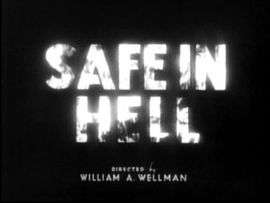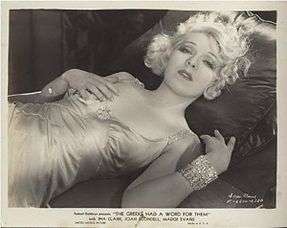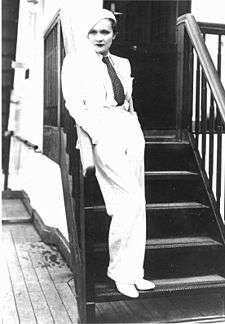Pre-Code sex films
Pre-Code sex films refers to movies made in the pre-Code Hollywood era, between the introduction of sound in the late 1920s[1] and the enforcement of the Motion Picture Production Code in 1934, which contained sexual references that were contrary to the yet to be enforced Hays Code. These movies explored woman's issues, challenged the concept of marriage, and aggressive sexuality was the norm.
Promotion


During the pre-Code period, after the crack down on crime films, production of films featuring prurient elements increased.[4][5] Studios began putting in extra suggestive material which they knew would never reach theaters. MGM screenwriter Donald Ogden Stewart said that "[Joy and Wingate] wouldn't want to take out too much, so you would give them five things to take out to satisfy the Hays Office—and you would get away with murder with what they left in."[6] In 1932, Warner Brothers' policy was that "two out of five stories should be hot", and that nearly all films could benefit by "adding something having to do with ginger."[7] Films such as Laughing Sinners, Safe in Hell, The Devil is Driving, Free Love, Merrily We Go to Hell, Laughter in Hell, and The Road to Ruin were provocative in their mere titles.[5] Studios marketed their films, sometimes dishonestly, by coming up with suggestive tag lines and lurid titles, even going so far as to come up with in house contests for thinking up provocative titles for screenplays.[8] Commonly labeled "sex films" by the censors, these pictures offended taste in more categories than just sexuality.[5] According to a Variety analysis of 440 pictures produced in 1932–33, 352 had "some sex slant", with 145 possessing "questionable sequences", and 44 being "critically sexual"."[7] The trade paper summarized that "over 80% of the world's chief picture output was...flavored with bedroom essence."[7] Attempts to create films for adults only (dubbed "pinking") only served to bring larger audiences of all ages to the cineplex.[9]
Posters and publicity photos were often tantalizing.[10] Woman appeared in poses and garb not even glimpsed in the films themselves. In some cases actresses with small parts in films, or in the case of Dolores Murray in her publicity still for The Common Law (1931),[11] no part at all, appeared barely clothed.[12]

Hays became outraged at the steamy pictures circulating in newspapers around the country.[13] The original Hays Code contained an oft ignored note about advertising imagery, but he wrote an entirely new set of advertising rules in the style of the ten commandments that contained a set of twelve prohibitions.[14] The first seven addressed imagery and prohibited women in undergarments, women raising their skirts, suggestive poses, kissing, necking, and other suggestive material. The last five concerned advertising copy and prohibited misrepresentation of the film's contents, "salacious copy", and the word "courtesan".[15] Soon, studios found their way around the restrictions and published more racy imagery. Ultimately this backfired in 1934 when a billboard in Philadelphia was placed outside Cardinal Thomas Dougherty's home. Severely offended, Dougherty helped launch the motion picture boycott that later facilitated the enforcement of the Code.[16] A commonly repeated theme by those supporting censorship, and one mentioned in the Code itself,[17] was the notion that film was a medium that greatly appealed to the masses and thus needed to be regulated.[18]
Despite the obvious attempts to appeal to red blooded American males, most of the patrons of sex pictures were female. Variety squarely blamed women for the increase in vice pictures:[19]
Women are responsible for the ever-increasing public taste in sensationalism and sexy stuff. Women who make up the bulk of the picture audiences are also the majority reader of the tabloids, scandal sheets, flashy magazines, and erotic books...the mind of the average man seems wholesome in comparison...Women love dirt, nothing shocks 'em.
Pre-Code female audiences liked to indulge in the carnal lifestyles of mistresses and adulteresses while at the same time taking joy in their usually inevitable downfall in the closing scenes of the picture.[20] And while gangster pictures were claimed to corrupt the morals of young boys, vice films were blamed for threatening the purity of adolescent women.[9]
In pre-Code Hollywood the sex film became synonymous with women's pictures—Zanuck once told Wingate that he was ordered by Warner Brothers New York corporate office to reserve 20% of the studio's output for "women's pictures, which inevitably means sex pictures."[21]
Content

Vice films typically tacked on endings where the most sin-filled characters were either punished or redeemed. Films explored Code-defying subjects in an unapologetic manner with the premise that an end-reel moment could redeem all that had gone before.[23] The concept of marriage was often tested. In The Prodigal (1931) a woman has an affair with a seedy character, and later falls in love with her brother-in-law. When her mother-in-law steps in at the end of the film it is to encourage her husband to grant her a divorce so she can marry the brother she is obviously in love with, proclaiming the message of the film: "This is the twentieth century. Go out into the world and get what happiness you can."[24] In Madame Satan (1930) adultery is explicitly condoned and is a sign for a wife that she needs to act in a more enticing way to maintain her husband's interest.[25] And in Secrets (1933) a husband admits to serial adultery, only this time he repents and the marriage is saved.[25] The films took aim at what was already a damaged institution. During the Great Depression, relations between spouses often deteriorated due to financial strain, marriages lessened, and husbands abandoned their families in increased numbers.[26] Marriage rates continually declined in the early 1930s, finally rising in 1934 and although divorce rates lowered, this is likely because desertion was a more financially apt method of separation.[27] Consequently, female characters in pictures such as Ruth Chatterton's in Female, live promiscuous bachelorette lifestyles, and control their own financial destiny (Chatterton supervises an auto factory) without regret.[21]
One of the most prominent examples of punishment for immoral transgressions in a vice film was The Story of Temple Drake (1933), where a promiscuous woman is raped and forced into prostitution. According to Thomas Doherty, the film implies that the deeds done to her are in recompense for her immorality.[28] And in the RKO film Christopher Strong, Katharine Hepburn plays an aviator who becomes pregnant from an affair with a married man. She commits suicide by flying her plane directly upwards until she breaks the world altitude record, at which point she takes off her oxygen mask and plummets to Earth.[29] Strong female characters often ended films as "reformed" feminists, after experiencing situations in which their progressive outlook proved faulty.[21]

Female protagonists in aggressively sexual vice films were usually of two general kinds: the bad girl or the fallen woman.[31] In so-called "bad girl" pictures, female characters profit from promiscuity and immoral behavior.[32] Jean Harlow, an actress who was by all reports a lighthearted, kind person off the screen, frequently played bad girl characters and dubbed them "sex vultures".[33] Two of the most prominent examples of bad girl films were Red-Headed Woman (1932) and Baby Face (1933). In Red-Headed Woman, Jean Harlow plays a secretary determined to sleep her way into a more luxurious lifestyle. She seduces her boss and intentionally breaks up his marriage. During her seductions, he tries to resist and slaps her, at which point she looks at him deliriously and replies "Do it again, I like it! Do it again!"[34] They eventually marry but Harlow seduces a wealthy aged industrialist who is in business with her husband so that she can move to New York. Although this plan succeeds, she is cast aside when she is discovered having an affair with her chauffeur, in essence cheating on her paramour. Harlow shoots the original boss, nearly killing him. When she is last seen in the film, she is in France in the back seat of a limousine with an elderly wealthy gentleman being driven along by the same chauffeur.[35] The film was a boon to Harlow's career and has been described as a "trash masterpiece."[36][37] Similarly, in Baby Face Barbara Stanwyck is an abused runaway determined to use sex to advance herself financially[38] and sleeps her way to the top of Gotham Trust.[39] Her progress is illustrated in a recurring visual metaphor of the movie camera panning ever upward along the front of Gotham Trust's skyscraper. Men are driven mad with lust over her and they commit murder, attempt suicide, and are ruined financially for associating with her before she mends her ways in the final reel.[40] In another departure from post Code films, Stanwyck's sole companion for the duration of the picture is a black woman named Chico she took with her when she ran away from home at age 14.[41]
Cinema classified as "fallen woman" films was often inspired by real-life hardships women endured in the early Depression era workplace. The men in power in these pictures frequently sexually harassed the women working for them. Remaining employed often became a question of a woman's virtue.[31] In She Had to Say Yes, a struggling department store offers dates with its female stenographers as an incentive to customers.[31] And Employees' Entrance was marketed with the tag line "See what out of work girls are up against these days."[31] Joy complained in 1932 of another genre, the "kept woman" film, which presented adultery as an alternative to the tedium of an unhappy marriage.[42]
Homosexuals were portrayed in several pre-Code films such as Our Betters, Footlight Parade, Only Yesterday, Sailor's Luck, and Cavalcade.[43] Although the topic was dealt much more openly than in the decades that followed, the characterizations of gay and lesbian characters were usually derogatory. Gay male characters were portrayed as possessing a high tone voice and a flighty personality. They existed merely as buffoonish supporting characters.[44] In films like Ladies They Talk About lesbians were portrayed as rough, burly characters, but in DeMille's The Sign of the Cross a female Christian slave is brought in front of a Roman prefect and seduced in dance by a statuesque lesbian dancer.[45] Fox nearly became the first American studio to use the word "gay" in reference to homosexuality, but the SRC made the studio muffle the word in the soundtrack of all reels that reached theaters.[46] Bisexual actress Marlene Dietrich cultivated a cross gender fan base and started a trend when she began wearing men's suits, a style which was an anachronism for the 1930s. She caused a commotion when she appeared at the premiere of the 1932 Pre-Code film The Sign of the Cross in a tuxedo replete with top hat and cane.[47] The backlash against homosexual characters appearing in films was rapid. In 1933 Hays declared that all gay male characters would be removed from pictures, and Paramount took advantage of the negative publicity Dietrich generated by signing a largely meaningless agreement stating that they would not portray women in male attire.[48]
See also
References
- ↑ LaSalle (2002). p.1
- ↑ Doherty. pg 280
- ↑ Fristoe, Roger. Safe in Hell, tcm.com, accessed October 11, 2010.
- ↑ Vasey p.114
- 1 2 3 Doherty. p.103
- ↑ Vieira. p.130
- 1 2 3 Doherty. p.104
- ↑ Doherty. pp.107-10
- 1 2 Smith. p.56
- ↑ Doherty. pp.110-1
- ↑ IMDb
- ↑ Doherty. p.110
- ↑ Doherty. p.111
- ↑ Doherty. pp.107, 110–2
- ↑ Doherty. pp.111-2
- ↑ Doherty. pp.112–3
- ↑ Reprinted in Jacobs. p.10: "Most arts appeal to the mature. This art appeals at once to every class, mature, immature, developed, underdeveloped, law abiding, criminal. Music has its grades for different classes; so has literature and drama. This art of the motion picture, combining as its does the two fundamental appeals of looking at a picture and listening to a story, at once reached [sic] every class of society. [Thus] it is difficult to produce films intended for only certain classes of people....Films, unlike books and music, can with difficulty be confined to certain selected groups"
- ↑ Doherty. pp.106-7; Massey. p.71
- ↑ Doherty. p.126
- ↑ Doherty. p.127
- 1 2 3 Vieira. pg. 118
- ↑ Siegel & Siegel. p.379
- ↑ Doherty. pg. 113
- ↑ Doherty. pp.113-4
- 1 2 Doherty. pg. 114
- ↑ McElvaine (Vol 2). pg. 1055
- ↑ McElvaine (Vol 1). pgs. 310–1
- ↑ Doherty. pgs. 117-8
- ↑ Doherty. pg. 128
- Christopher Strong, timeout.com, accessed November 11, 2010.
- ↑ Doherty. pgs. 124–5
- 1 2 3 4 Doherty. pg. 131
- ↑ Doherty. pg. 132
- ↑ LaSalle (1999). pg. 127
- ↑ LaSalle (1999). pg. 130
- ↑ Doherty. pg. 130
- ↑ Hanke, Ken. Red-Headed Woman, Mountain Xpress, November 20, 2007, accessed October, 11, 2010.
- ↑ Schwartz, Dennis. Red-Headed Woman, January 2, 2007, accessed October 11, 2010.
- ↑ LaSalle, Mick. 'Baby Face' now better (and racier) than ever before, February 3, 2006, accessed October 11, 2010.
- ↑ Burr, Ty. Uncut version of 'Baby Face' is naughty but nice, Boston Globe, April 7, 2006, accessed October 11, 2010.
- ↑ Hall, Mordaunt. Baby Face (1933) - A Woman's Wiles., The New York Times, June 24, 1933, accessed October 11, 2010.
- ↑ Doherty. pg. 277
- ↑ Smith. pg. 53
- ↑ Vieira. pgs. 132–3
- ↑ Doherty. pg. 121
- ↑ Doherty. pg. 122
- ↑ Vieira. pg. 133
- ↑ Doherty. pg. 123
- Siegel & Siegel. pg. 124
- ↑ Doherty pg. 125
Sources
- Bernstein, Matthew. Controlling Hollywood: Censorship and Regulation in the Studio Era. Rutgers University Press 1999 ISBN 0-8135-2707-4
- Black, Gregory D. Hollywood Censored: Morality Codes, Catholics, and the Movies. Cambridge University Press 1996 ISBN 0-521-56592-8
- Doherty, Thomas Patrick. Pre-Code Hollywood: Sex, Immorality, and Insurrection in American Cinema 1930-1934. New York: Columbia University Press 1999. ISBN 0-231-11094-4
- Hughes, Howard. Crime Wave: The Filmgoers' Guide to the Great Crime Movies. I. B. Tauris 2006 ISBN 1-84511-219-9
- Jacobs, Lea. The Wages of Sin: Censorship and the Fallen Woman Film, 1928-1942. Madison: University of Wisconsin Press 1997 ISBN 0-520-20790-4
- Jeff, Leonard L, & Simmons, Jerold L. The Dame in the Kimono: Hollywood, Censorship, and the Production Code. The University Press of Kentucky 2001 ISBN 0-8131-9011-8
- LaSalle, Mick. Complicated Women: Sex and Power in Pre-Code Hollywood. New York: St. Martin's Press 2000 ISBN 0-312-25207-2
- Lewis, Jen. Hollywood V. Hard Core: How the Struggle Over Censorship Created the Modern Film Industry. NYU Press 2002 ISBN 0-8147-5142-3
- Massey, Anne. Hollywood Beyond the Screen: Design and Material Culture. Berg Publishers 2000 ISBN 1-85973-316-6
- McElvaine, Robert S. (editor in chief) Encyclopedia of The Great Depression Volume 1 (A-K). Macmillan Reference USA 2004 ISBN 0-02-865687-3
- McElvaine, Robert S. (editor in chief) Encyclopedia of The Great Depression Volume 2 (L-Z). Macmillan Reference USA 2004 ISBN 0-02-865688-1
- Siegel, Scott, & Siegel, Barbara. The Encyclopedia of Hollywood. 2nd edition Checkmark Books 2004. ISBN 0-8160-4622-0
- Smith, Sarah. Children, Cinema and Censorship: From Dracula to the Dead End Kids. Wiley-Blackwell 2005 ISBN 1-4051-2027-4
- Turan, Kenneth. Never Coming to a Theater Near You: A Celebration of a Certain Kind of Movie. Public Affairs 2004 ISBN 1-58648-231-9
- Vasey, Ruth. The World According to Hollywood, 1918-1939. University of Wisconsin Press 1997 ISBN 0-299-15194-8
- Vieira, Mark A. Sin in Soft Focus: Pre-Code Hollywood. New York: Harry N. Abrams, Inc. 1999. ISBN 0-8109-8228-5